In What Ways Did Renaissance Art and Philosophy Reinforce Each Other?
The Italian Renaissance flow was a revival of the ideals and civilization lost during previous years of war, equally well as a resurgence in the various social and political differences inside Europe during the Medieval historic period. This revival led to a complete shift in perspectives – quite literally and figuratively – in Italian fine art and civilization. Overall, it was a new time for Europe, and it became a menstruation of history that would live on for ages to come.
Tabular array of Contents
- 1 What Was the Italian Renaissance?
- 1.1 A "Rebirth"
- 1.2 Historical Perspectives Nigh the Italian Renaissance
- 2 Italian Renaissance Characteristics
- 2.1 Naturalism and Realism
- 2.2 Contrapposto
- 2.3 Chiaroscuro
- ii.4 Linear Perspective (One-Signal Perspective)
- 3 Distinguishable Italian Fine art Periods and Artists
- 3.ane Proto-Renaissance (Trecento)
- 3.ii Early Renaissance (Quattrocento)
- three.3 Loftier Renaissance (Cinquecento)
- iv Renaissance Beyond Italy and Into the Futurity
- v Ofttimes Asked Questions
- 5.1 What Was the Italian Renaissance?
- 5.two When Did the Italian Renaissance Start?
- 5.3 What Characterized the Italian Renaissance?
What Was the Italian Renaissance?
Below, we will hash out the origins of the term renaissance, also as an overview of how this catamenia in Italian republic emerged from prior historical events like the Medieval ages, which catalyzed the growth and development of this movement.
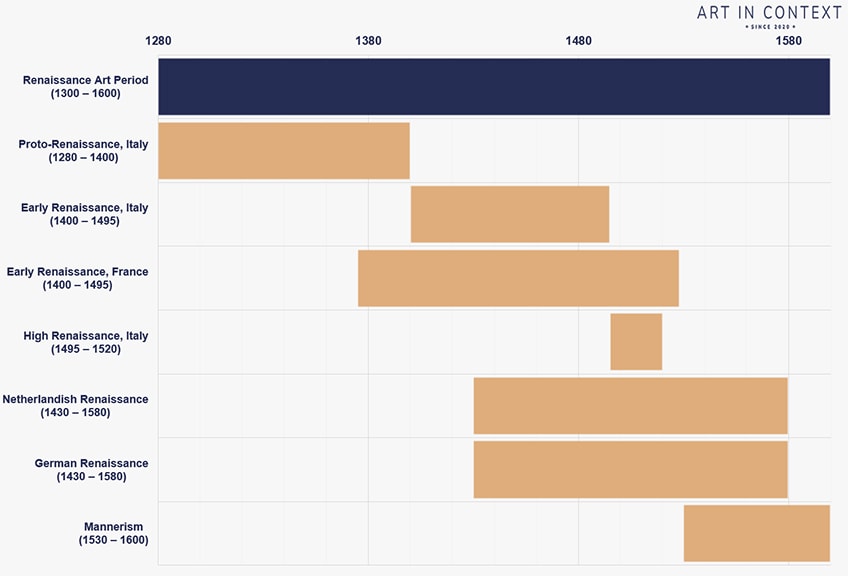
A "Rebirth"
The Renaissance is said to accept started in Italy during the 1300s. It was a revival in arts, architecture, literature, music, culture, engineering, science, theology, geography, and politics. The Renaissance was a menstruation of "rebirth", which found its way throughout numerous countries in Europe.
This "rebirth" also sought to reawaken what is referred to as "classical antiquity" from the ancient times of Greek and Rome. The Italian Renaissance was a new discovery of the humanities, and really, of humanity itself.
Italian Renaissance artists focused more on the ideas of humanism and naturalistic portrayals of the world and people around them.
In fact, the word renaissance itself is a French give-and-take, merely its origins come from the Italian give-and-take rinascita, which ways "rebirth". Giorgio Vasari (1511-1574), a man of many talents (he was an artist, art theorist, builder, author, and engineer), first introduced this term to describe this new period of enkindling in Italy in his publication Le Vite, meaning "The Lives".
Le Vite was considered 1 of the best publications virtually fine art history, especially during the Italian fine art period. It was written in a biographical format almost various artists, architects, and sculptors (its longer championship is Le vite de' pi ù eccellenti pittori, scultori, e architettori, which means "The Lives of the Nearly Excellent Painters, Sculptors, and Architects").
 Plate of Giorgio Vasari, from Le vite de' piv eccellenti pittori, scvltori, due east architettori (Fiorenza: Appresso i Giunti, 1568), by Giorgio Vasari (1511-1574);Houghton Library, Public domain, via Wikimedia Commons
Plate of Giorgio Vasari, from Le vite de' piv eccellenti pittori, scvltori, due east architettori (Fiorenza: Appresso i Giunti, 1568), by Giorgio Vasari (1511-1574);Houghton Library, Public domain, via Wikimedia Commons
Historical Perspectives About the Italian Renaissance
The Italian Renaissance menstruum is said to have started during the 1300s (the 14th Century). This was during the Medieval menstruum in Italy's history, also chosen the Eye Ages, which is said to accept occurred during the 400s to late 1400s in Europe. The Middle Ages can be looked at from the Early Centre Historic period, Loftier Middle Age, and Late Middle Age. Each stage had its ain challenges politically, environmentally, and economically, which impacted the whole of Europe and the world.
The Middle Ages is as well known as the "Dark Ages" because of widespread wars, pandemics like the Black Death, and famines as a event of climate changes and economic upheavals. There were many meaning events during the Middle Ages. The Fall of the Roman Empire (c. 476 CE) and the overthrow of Roman Emperor Romulus Augustulus in the west led to the first of the Middle Ages, including the rise of Christianity and Catholicism and widespread invasions and migrations of people across the countries.
From the autumn of the Roman Empire to the rise of the Middle Ages, the Renaissance became a flow of transition into a lighter age of existence.
Early Italian Renaissance fine art started in Florence, Italy, due to the motion'due south roots in the Roman Empire besides equally the wealthy families willing to support the arts. There were two of import contributing factors during the Renaissance catamenia, namely, the movement of philosophical ideals called Humanism, and the influence of wealthy families, specifically the Medici family.
Humanism
Humanism started during the 1300s, and is referred to as an "intellectual motion" of the time. It was deeply rooted in philosophical ideas around the importance of man and his place in order. This opposed the Medieval ideals that focused more on the importance of the spiritual and divine – it focused on the role of the centrality of the above two figures, namely homo and God.
Renaissance Humanism explored and studied different schools of idea, such as grammar, history, moral philosophy, poetry, and rhetoric – this was known as the studia humanitatis. These topics of study were considered acceptable towards the study of classical values. This new form of didactics was likewise open not only to elites simply the public besides, including new humanist libraries.
 Dante, Pétrarque, Guido Cavalcanti, Boccacce, Cino da Pistoia et Guittone d'Arezzo (1544) by Giorgio Vasari;Giorgio Vasari, Public domain, via Wikimedia Commons
Dante, Pétrarque, Guido Cavalcanti, Boccacce, Cino da Pistoia et Guittone d'Arezzo (1544) by Giorgio Vasari;Giorgio Vasari, Public domain, via Wikimedia Commons
The Humanists placed human as the central deciding figure of personal ability. In other words, man was at the heart of new intellectual pursuits like logic, aesthetics, classical principles, the arts, and sciences like mathematics. The rule of the Church, which was such a big part of European guild, was redefined in terms of its efficacy in determining what man should do or who human should be.
The term "Renaissance Homo" became a popular description for people with this newfound power.
There was a large resurgence and revisiting of Greek and Latin literature on various subjects during the beginning stages of the Renaissance. Many of these classical texts informed the new approaches taken in painting, compages, and the principles of perspective and beauty.
An instance of a classical text was the work done by Vitruvius, who was a Roman architect. Vitruvius wrote about his ideals during the onest Century BC, namely his "Vitruvian Triad", which was based on the principles of beauty, unity, and stability. This placed a focus on applying mathematical proportions to the faculties of arts like painting, architecture, and especially the proportions of the human trunk.
Petrarch (1304-1374), the well-known poet, was known as the "father of the Renaissance" as he was the leading figure who catalyzed the Humanist movement. Although the Catholic Church had a large role of ability during this fourth dimension, and Petrarch was a Catholic himself, he nonetheless believed that humans had been given power by God to realize their potential – this form of thought was at the center of Humanism.
It is important to notation that Petrarch institute the writings of early Roman, Marcus Tullius Cicero (106-43 BC), which he translated.
Plato (428/427 BCE-348/347 BCE), a Greek philosopher, was some other influential effigy for the Renaissance Humanists. Plato'south philosophies were introduced at the Council of Florence during the years 1438 to 1439 by George Gemistus Plethon, or Pletho (c. 1355-1450/1452), who was a philosopher during the Byzantine era. The importance of this was that it influenced Cosimo de' Medici, who was a significant figure of economic power in Florence.
It is believed that Cosimo de' Medici sponsored the Accademia Platonica, "Platonic University", where Marsilio Ficino (1433-1499), an Italian Cosmic priest, translated Plato'south works. However, this has been disproved by several scholarly sources, who have stated that Ficino's writings were non translated correctly. Ficino called Plethon the "the second Plato" due to his influence in bringing Plato's works to the west.
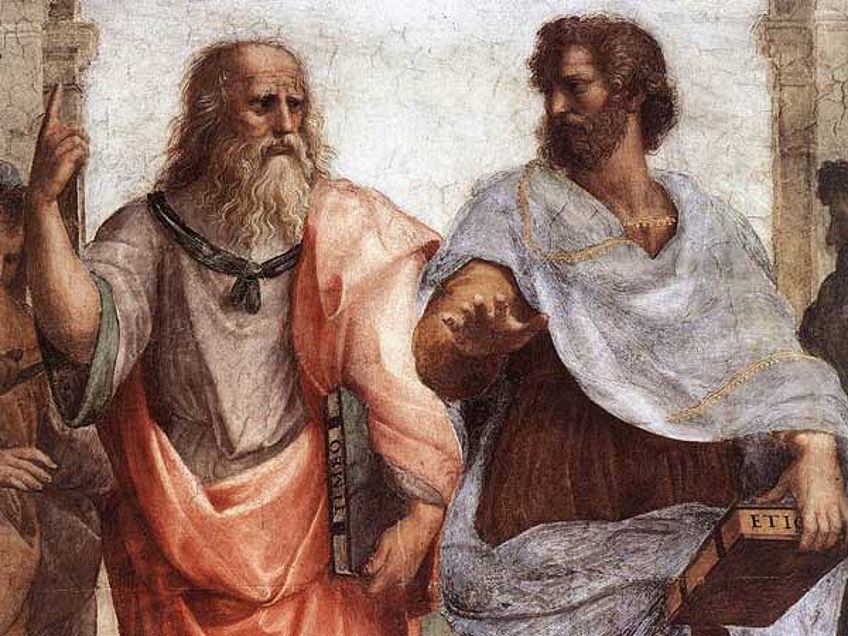 A cropped section of Raphael'south School of Athens (1509), showing Plato (left), pointing up to the ethics, and Aristotle (right), reaching out towards the concrete world;Raphael, Public domain, via Wikimedia Eatables
A cropped section of Raphael'south School of Athens (1509), showing Plato (left), pointing up to the ethics, and Aristotle (right), reaching out towards the concrete world;Raphael, Public domain, via Wikimedia Eatables
The Medici Family
This brings us to the Medici family unit, or House of Medici, of import influencers on fine art, economy, politics, and full general Italian club during the Renaissance. This took identify mostly in Florence, which became the capital for post-obit the ideas from the Classical era – information technology was also known as the "New Athens".
During the 1200s, the Medici family began worked in banking and commerce in Florence afterward they moved from their habitation in Tuscany. The Medici Bank was started by Giovanni di Bicci de' Medici (c. 1360-1429), who was the begetter of Cosimo de' Medici (1389–1464), who ruled Florence.
What is important to know nearly the Medici family unit is their patronage of the art globe. Cosimo de' Medici commissioned many artists to produce paintings and also started the public library in Florence, amid other endeavors that supported the development of the arts in Florence. Cosimo de' Medici'southward love of fine art, and collecting it, is often elaborated past his quote:
"All those things accept given me the greatest satisfaction and contentment because they are not just for the honour of God, but are likewise for my own remembrance. For fifty years, I accept done nil else merely earn money and spend money, and information technology became clear that spending money gives me greater pleasure than earning information technology".
Italian Renaissance Characteristics
There are a number of themes and motifs found within many Renaissance paintings, too as sure techniques used by many of the artists of the time. It is by locating these characteristics that 1 is able to identify a Renaissance piece of art.
Naturalism and Realism
Naturalism in Italian fine art depicted subject matter in a more than realistic manner. In other words, information technology reflected the external globe and people as they appeared. This was also feature of Greek and Roman art, and something that the Italian Renaissance artists sought to emulate. Some other word for this is termed Realism.
The element of realism was at its best evident in how artists chose to depict anatomy, whether in paintings or sculpture. Many artists studied the human figure, in fact, to gain a improve understanding of how the human body worked and looked. Some artists like Leonardo da Vinci fifty-fifty studied real corpses.
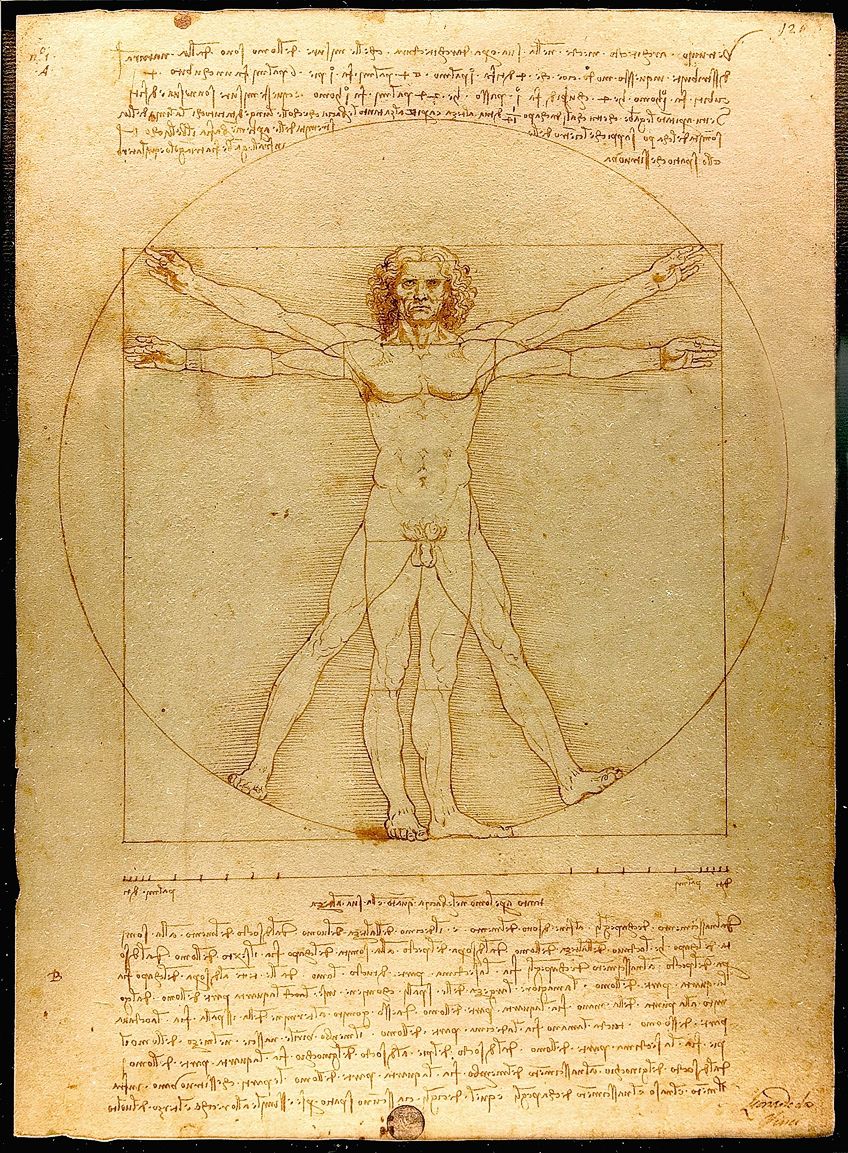 Da Vinci'southward Vitruvian Human being (c. 1942);Leonardo da Vinci, Public domain, via Wikimedia Commons
Da Vinci'southward Vitruvian Human being (c. 1942);Leonardo da Vinci, Public domain, via Wikimedia Commons
Contrapposto
There are various painting techniques that artists started utilizing to increment the result of realism in human figures. One example is contrapposto, which means "counterpoise" in Italian. Figures would be placed with one side of the body leaning dominantly on 1 foot while the other side of the body, anxiety, and hips, would announced lower – otherwise understood every bit the center of gravity existence heavier on one side than the other. This technique of portraying a effigy fabricated it announced more than life-like and dynamic. Additionally, the figure would announced to convey more than emotion due to the indication of body language.
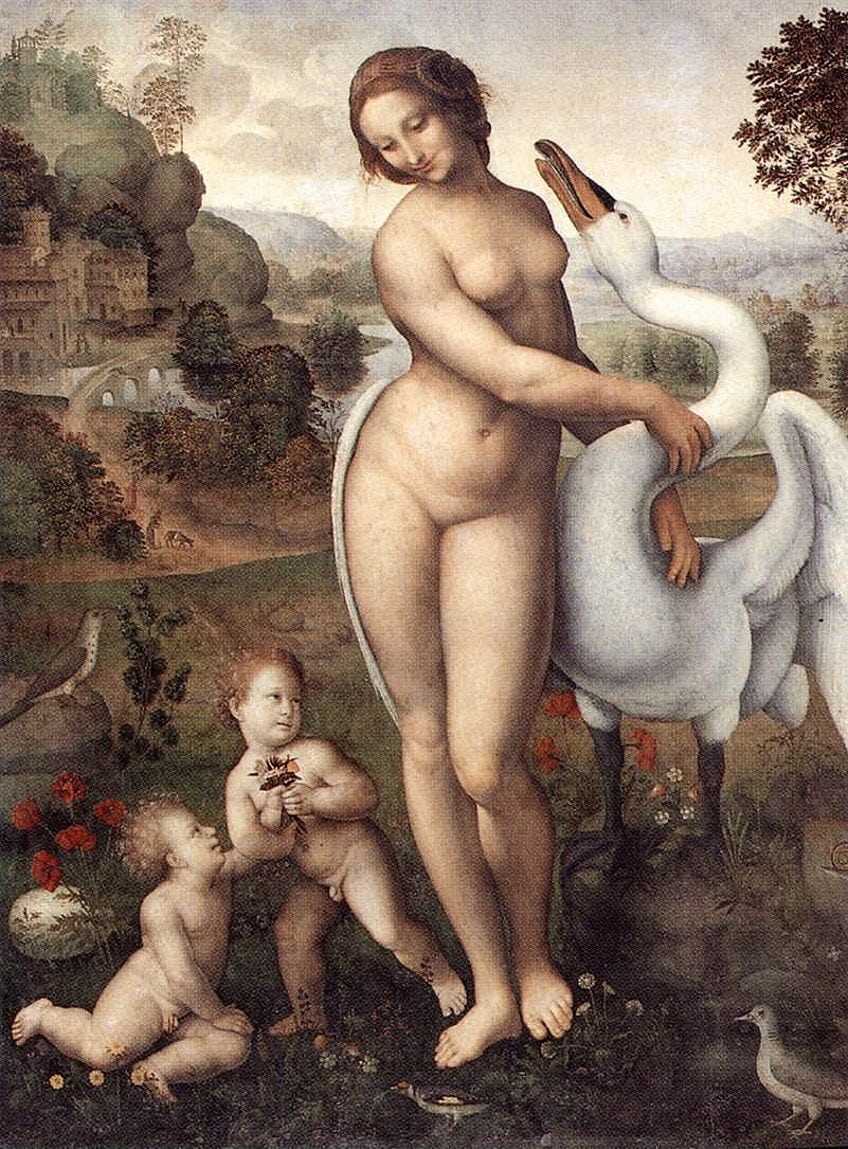 Leda and the Swan (c. 1510-1515) by Leonardo da Vinci; Subsequently Leonardo da Vinci, Public domain, via Wikimedia Commons
Leda and the Swan (c. 1510-1515) by Leonardo da Vinci; Subsequently Leonardo da Vinci, Public domain, via Wikimedia Commons
Chiaroscuro
Another artistic technique used was the dissimilarity between light and dark, otherwise known as chiaroscuro, an Italian word meaning "low-cal-nighttime". Artists used this technique to convey depth and dramatic emphasis in their compositions. This would also create a sense of realism by depicting the way light and shadow would appear in the real environment, thus giving the whole composition a three-dimensionality, which was a considerable change from the two-dimensional spaces from before art periods.
 St Peter's Deprival(1660) by Rembrandt. With his left mitt, the disciple Peter makes a gesture of denial in response to the accusations made by Caiaphas' maidservant, who is standing next to him holding a candle. To the left, two soldiers in armor are present, 1 of whom is sitting at a table. To the correct, a chained Christ looks over his shoulder while he is existence taken away; Rembrandt, Public domain, via Wikimedia Eatables
St Peter's Deprival(1660) by Rembrandt. With his left mitt, the disciple Peter makes a gesture of denial in response to the accusations made by Caiaphas' maidservant, who is standing next to him holding a candle. To the left, two soldiers in armor are present, 1 of whom is sitting at a table. To the correct, a chained Christ looks over his shoulder while he is existence taken away; Rembrandt, Public domain, via Wikimedia Eatables
Linear Perspective (One-Indicate Perspective)
The use of linear perspective, or one-betoken perspective, also enhanced the sense of realism in paintings giving it a three-dimensionality. This technique was first pioneered by Filippo Brunelleschi (1377 – 1446), an Italian builder and designer. He was besides considered as 1 of the "fathers" of the Renaissance flow because of his pioneering discoveries in design and architecture from a scientific and mathematical signal of view.
It is believed that Brunelleschi also studied aboriginal Roman architectural structures and sculptures. The one-bespeak perspective focused on a chosen single viewpoint of lines converging on the horizon. This was different from how the multiple viewpoints were shown in paintings during the Centre Ages.
The dome of the Cattedrale di Santa Maria del Fiore, or "Cathedral of Saint Mary of the Flower" (1377-1446), is a well-known structure in Florence engineered by Brunelleschi. The dome moved away from the well-known Flight Buttresses used during the Medieval Ages' Gothic Architecture. It was created using various self-sustaining reinforcements with a large lantern at the superlative tip of the dome, otherwise known equally the cupola.
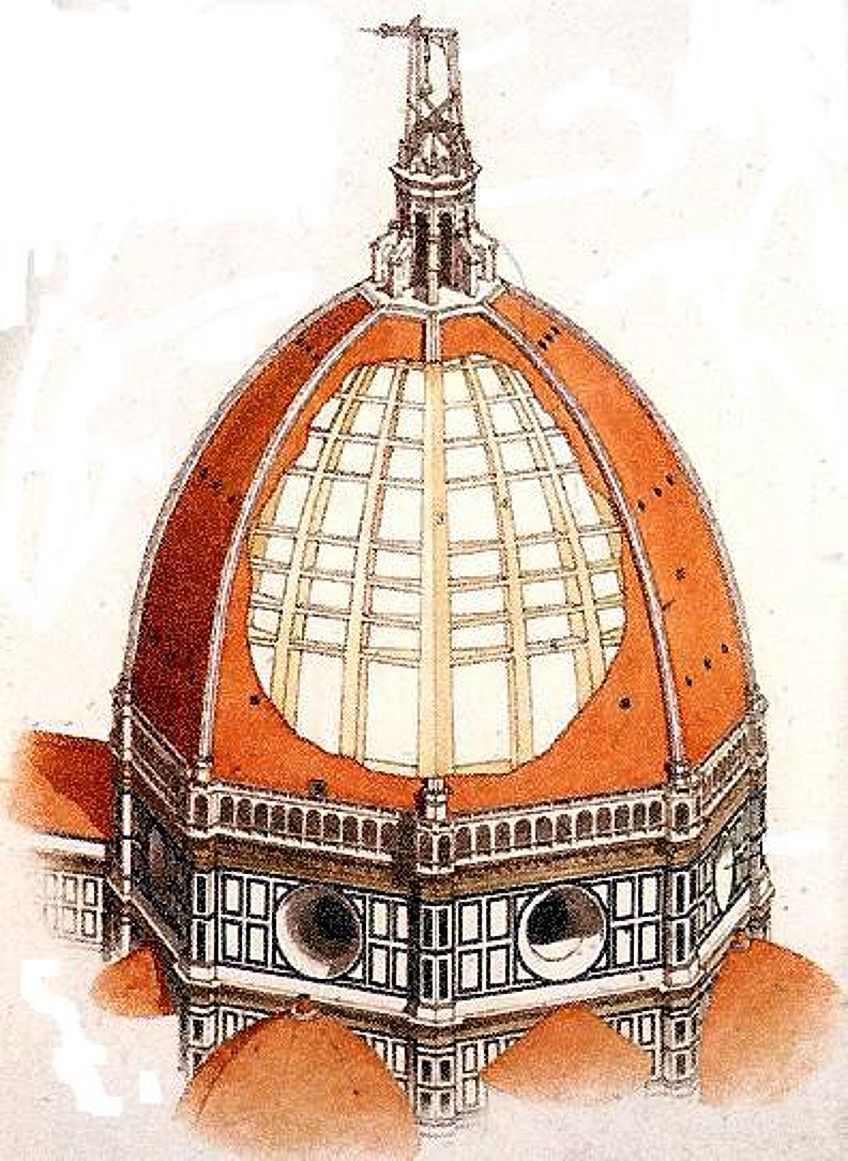 A cutaway of the Dome of Florence Cathedral (Santa Maria del Fiore), designed by Filippo Brunelleschi, 1414-36; Public Domain, Link
A cutaway of the Dome of Florence Cathedral (Santa Maria del Fiore), designed by Filippo Brunelleschi, 1414-36; Public Domain, Link
Distinguishable Italian Art Periods and Artists
The Italian Renaissance tin can be easier understood past looking at it in different periods. While some divide it into four periods, the fourth existence Mannerism, here we will look at the three primary divisions that took place related to the Italian Renaissance periods. Beneath, nosotros will discuss the timeframes and prominent artists.
Proto-Renaissance (Trecento)
The Proto-Renaissance period occurred during the 1300s, and is otherwise referred to every bit Trecento in Italian, meaning "300". The exact years fall between 1300 and 1425. The Proto-Renaissance began as the first transition into the Renaissance period. What started characterizing this period of art (painting, sculpture, and architecture) were the naturalistic portrayals of subjects.
Giotto di Bondone (c. 1267 – 1337)
I of the pioneering artists during the Proto-Renaissance menstruum was Giotto di Bondone, born in Florence, Italy. He was a painter and architect and considered to be one the all-time painters of his time. He was an apprentice to the artist Bencivieni (Cenni) di Pepo, besides known equally Cimabue (c. 1240-1302) who was known for exploring the very first elements of naturalism during the Byzantine flow earlier the Renaissance. Giotto, however, is reported by scholarly sources to have overtaken Cimabue in his skill to portray nature around him with an increased sense of realism and a keen middle for item.
He is known as emphasizing humanity in his paintings, enhanced by his use of perspective, emotive details in his figures, and the lavish costumes worn by them.
Giotto'due south subject affair was of Christian narratives and figures, and he was commissioned past the Church for several frescoes, namely, Isaac Blessing Jacob (c. 1290-1295), which is in the Basilica of St. Francis of Assisi. Giotto painted the biblical story from the Erstwhile Testament depicting Jacob giving his father food with Rebekah, Jacob's female parent, continuing next to Jacob and Isaac.
A fundamental piece of work by Giotto is Lamentation (The Mourning of Christ) (1305), which is a fresco done for the Scrovegni Chapel (Arena Chapel) located in Padua, which is a urban center in Italy. This fresco is non a stand up-alone painting, it is role of a series of frescoes that Giotto painted for the chapel about Christ and Mother Mary's lives.
 The Lamentation (1305) scene from the cycle of frescoes done past Giotto for the arena chapel in Padua (Scrovegni Chapel);Giotto di Bondone, Public domain, via Wikimedia Eatables
The Lamentation (1305) scene from the cycle of frescoes done past Giotto for the arena chapel in Padua (Scrovegni Chapel);Giotto di Bondone, Public domain, via Wikimedia Eatables
Lamentation depicts the events when Christ was taken from the cross, and we can see the surrounding figures grieving over his expiry as Mother Mary holds him in her arms. Nosotros tin can see around 10 figures in the foreground receding into more in the background. Above the crowd are 10 grieving angels also twisting in credible sadness.
What makes this painting unique and a grand example of the beginnings of the Early on Italian Renaissance art is how Giotto portrayed item in the faces of the surrounding figures, as well equally their arms and hands conspicuously visible in their gesticulation. The sloping of the rock on the correct almost moves down to create more emphasis on Christ on the floor.
The in a higher place elements all create a sense of perspective and depth to the painting, including the receding figures to the left of the background. Information technology is virtually every bit if Giotto is connecting heaven and globe with the sloping stone in the centre, which creates more than realism and a sense of connexion with the divine.
Ognissanti Madonna (c. 1300-1306) is another important work by Giotto depicting the naturalistic style characteristic of the Renaissance menses. Information technology depicts Madonna with the Christ Child seated on her left leg, holding his correct hand upward in a gesture of blessing. The 2 primal figures, Madonna and the Christ Child are depicted considerably larger than the surrounding figures.
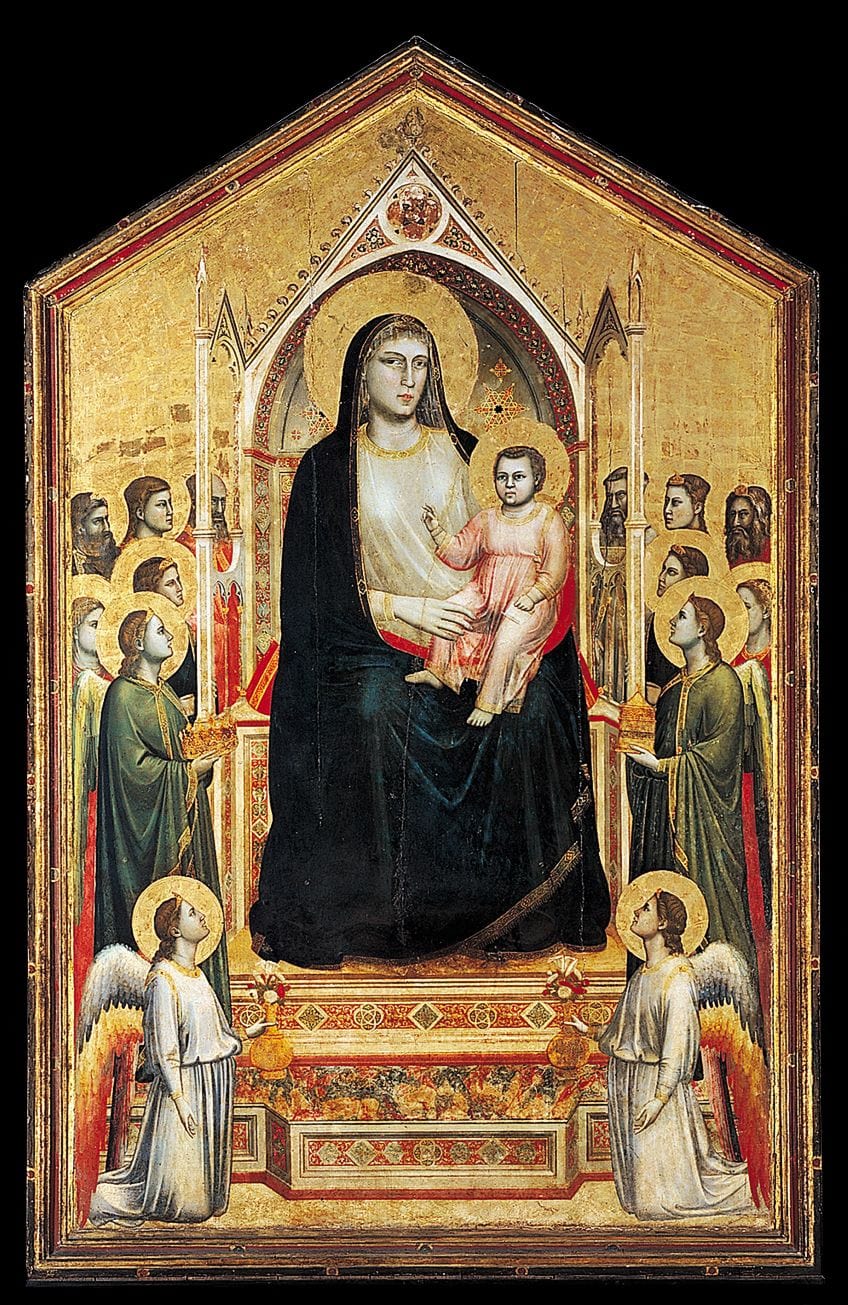 Giotto's Madonna Enthroned (Ognissanti Madonna) (c. 1300-1306);Giotto di Bondone, Public domain, via Wikimedia Commons
Giotto's Madonna Enthroned (Ognissanti Madonna) (c. 1300-1306);Giotto di Bondone, Public domain, via Wikimedia Commons
The throne is also depicted larger with two angels kneeling by its steps. We also notice how all the surrounding angelic figures are looking at the Madonna with Child, which indicates how the artist uses perspective and spatial altitude to lead the viewer to the focal point.
Furthermore, Giotto painted the Madonna and Child more realistically by the way their fine wear, almost see-through, folds around their body, indicating the flesh underneath. This shows us the human aspects of the divine, making it easier to relate to these hallowed figures.
Cimabue may accept painted the same scene earlier Giotto, nevertheless, what makes Giotto'southward painting of the Madonna and Kid unique is his realism and detailed depiction of not but the human being figures and their expressions, just also the architectural detail of the throne.
Giotto inspired many more sculptors and painters during the Early Renaissance menstruation considering of the above stylistic innovations.
Early on Renaissance (Quattrocento)
The Early on Renaissance menstruation occurred during the 1400s, and is also referred to as Quattrocento, which means "400" in Italian. The exact years can fall betwixt 1425 and 1495. When nosotros wait at paintings from this period, we find how artists started to portray a keener eye to detail in their subject matter.
Influenced by the forerunners of Renaissance paintings like Cimabue and Giotto, artists focused on the realistic delineation of human figures and anatomical correctness. Artists also utilized more intentional perspectives of figures and buildings and their placements within the space effectually them. This mastery of the mathematically aligned perspective and placement of various religious bailiwick matter is particularly evident in Pierro della Francesca'southward work, such asThe Baptism of Christ (c. 1448-1450) and The Flagellation of Christ (c. 1455).
 Baptism of Christ (c. 1448-1450) by Pierro della Francesca;Piero della Francesca, Public domain, via Wikimedia Commons
Baptism of Christ (c. 1448-1450) by Pierro della Francesca;Piero della Francesca, Public domain, via Wikimedia Commons
Although the Early Renaissance artists yet portrayed scenes from the Bible and narratives around what the Church valued, they started to incorporate mythological subject matter as well every bit everyday occurrences and people, which shifted the focus off of the holy and onto the ordinary – ultimately making art more relatable for the anybody.
Alongside new subject matter, we will also notice how artists depicted more emotion and homo-like qualities in their subject area matter. This reinforced the notion of Humanism that many artists strove to emphasize, again bridging the divide betwixt the divine and man, placing man as the fundamental figure experiencing life, nature, and God.
Some of the leading painters and sculptors during this flow were Tommaso di Ser Giovanni di Simone, generally known as Masaccio (1401-1428), and Donato di Niccolò di Betto Bardi, named Donatello (c. 1386-1466). Masaccio is highly regarded as one of the pioneers of Renaissance painting, especially for his utilize of linear perspective and creating truthful-to-nature depictions of his human figures. He was influenced past other prominent artists like Brunelleschi and Donatello.
Donatello (c. 1386 – 1466)
Born in Florence, Donatello became 1 of the best sculptors during this period of the Renaissance. He was exposed to a rich education growing up and his educational activity as an creative person started with tutelage from a goldsmith. He also worked as a goldsmith while he pursued his creative career. He was close friends with Brunelleschi and traveled with him to diverse Greek and Roman ruins where he found considerable inspiration for his work every bit an artist.
What set Donatello autonomously as i of the forerunners of Renaissance sculpture was the way in which he utilized perspective in his sculptures. He also used various subject matters, ranging from Mary Magdalene as nosotros meet in his hyper-realistic wooden carved statue, The Penitent Magdalene (c. 1453) to political figures equally we see in the Bust of Niccolo da Uzzano (c. 1433).
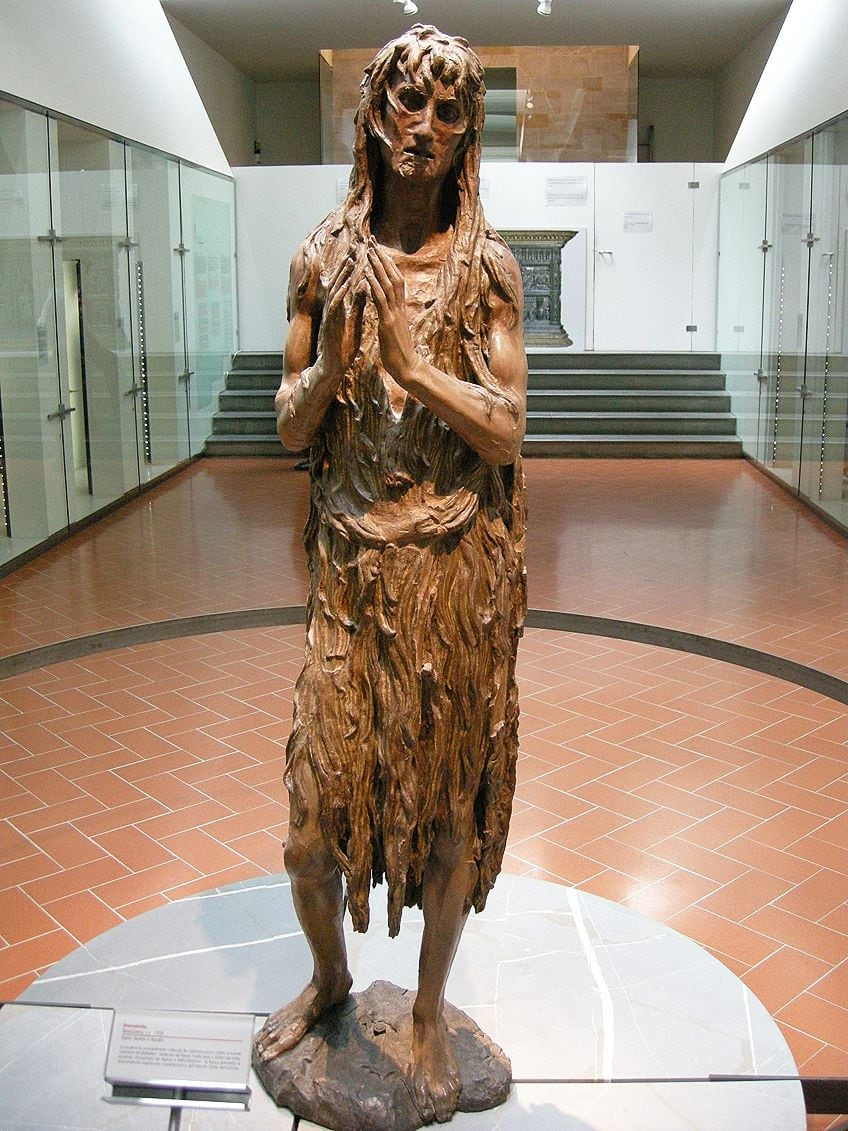 Donatello's statue, Penitent Magdalene (Mary Magdalene)(1453-1455); I, Sailko, CC BY-SA three.0, via Wikimedia Commons
Donatello's statue, Penitent Magdalene (Mary Magdalene)(1453-1455); I, Sailko, CC BY-SA three.0, via Wikimedia Commons
Donatello introduced new techniques in his sculptures, namely referred to as bas-relief, which is likewise called low relief. This depicted a sense of three-dimensionality due to the part of the sculpture being slightly raised from the surface, otherwise characterized as having "shallow depth". This is evident in his earlier relief titled, St. George Killing the Dragon (1416-1417), which makes up the base of his marble statue, St. George (1415-1417).
David (1440-1443) is one of the more famous sculpted masterpieces past Donatello. Fabricated of bronze, this depicts David continuing at 5 feet in height wearing a hat and boots, a sword in his right paw, and the helmet of Goliath partly between his legs. Donatello revolutionized the paradigm of David during this fourth dimension by depicting him as a young human being in the nude, which was the first nude sculpture created since the Greek and Roman menses.
Furthermore, this sculpture denotes a sense of gentleness and femininity in the depiction of David, and many scholarly sources discuss Donatello'southward reason for portraying the biblical effigy in this manner. An important indicate to note about this sculpture is that it was made as a freestanding statue and not part of an architectural structure. The figure also stands in the characteristic contrapposto pose, making him more life-like and relatable as a human being beingness instead of a biblical character removed from the everyday experiences of the people.
 Donatello's Bronze David statue (c. 1430-1450); Donatello, CC By-SA 2.0, via Wikimedia Eatables
Donatello's Bronze David statue (c. 1430-1450); Donatello, CC By-SA 2.0, via Wikimedia Eatables
We will run into this character revisited in Michelangelo's similarly titled statue during the later Renaissance periods.
Masaccio (1401 – 1428)
Masaccio was born in the Arezzo province in Tuscany and was considered the first Early Renaissance painters to utilize linear perspective. Influenced by how the architect Brunelleschi utilized perspective, Masaccio started to use these techniques in his paintings, which revolutionized the way artists composed paintings from the two-dimensional depictions of the by. He as well used other techniques similar chiaroscuro to emphasize depth and 3-dimensionality, including achieving a deeper realism in his paintings.
Masaccio's San Giovenale Triptych (1422) is an early piece of work from the creative person. The Vanni Castellani family unit commissioned this work. It depicts religious scenes of the Virgin Mary with the Christ Child at the center, with two saints on both the left and right panels. From inscriptions below the triptych, it is indicated that the Saints Bartholomew and Blaise are on the left, and Saints Antony and Juvenal are on the correct.
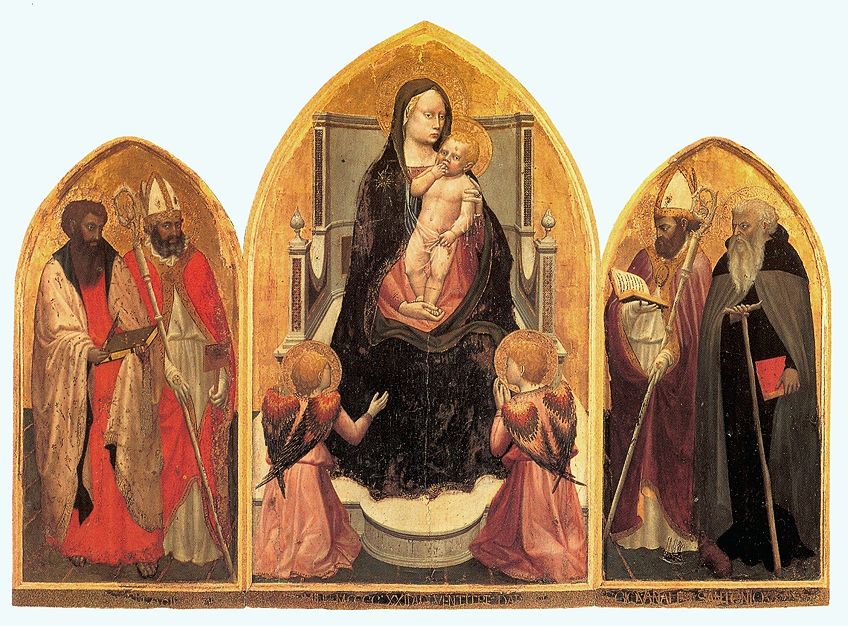 San Giovenale Triptych (1422) by Masaccio;Masaccio, Public domain, via Wikimedia Commons
San Giovenale Triptych (1422) by Masaccio;Masaccio, Public domain, via Wikimedia Commons
We as well detect how Masaccio introduces an intentional perspective within the limerick by the throne receding in the groundwork in contrast to the figures appearing larger in the foreground. I of his later works, Payment of the Tribute Money (1425 – 1427), epitomizes his success with using linear perspective and more than mathematically correct placements of his figures to indicate a sense of unity and harmony.
This work was washed every bit a fresco for the Brancacci Chapel of Santa Maria del Carmine located in Florence. It depicts what is referred to equally a "continuous narrative" – in other words, in that location are 3 stories portrayed in i fresco painting. It tells the story of Christ and St. Peter paying the tax collector.
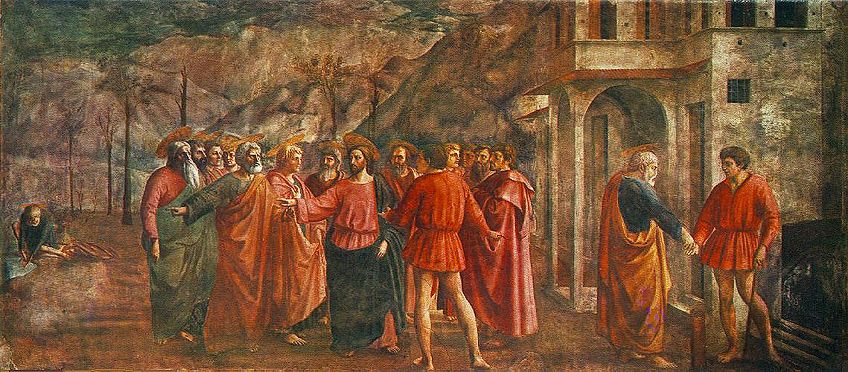 Tribute Money (1426/1427) by Masaccio;Masaccio, Public domain, via Wikimedia Commons
Tribute Money (1426/1427) by Masaccio;Masaccio, Public domain, via Wikimedia Commons
We will notice how the starting time role of the narrative is portrayed in the center of the fresco, depicting Christ with his apostles in conversation with the tax collector, who has his dorsum to the viewer. We see how Christ points his finger to the left with Peter on his left, also pointing his finger to the left.
This almost moves us to the left side of the fresco, the second role of the narrative, where we see Peter angle down by the river getting coin from the rima oris of a fish. This narrative is easily understood from the Gospel of Matthew about the business relationship of Jesus paying tax at the line-fishing village called Capernaum. During the chat Jesus says to Peter, as accounted in the bible, "Take the first fish you catch; open its mouth and yous will find a four drachma coin. Accept it and give it to them for my tax and yours".
When nosotros await at the correct side, the third part of the narrative of the fresco, we notice Peter again, but this time it is only himself and the tax collector, who is receiving the taxation money taken from the fish'south mouth. The way in which the figures are gesticulating and talking with one another, every bit well every bit the item on their facial expressions, gives the painting its realism.
We also come across the three-dimensionality indicated from the fashion in which the mountains recede in the background, including the revenue enhancement collector with his dorsum to us. Furthermore, Masaccio also included light and nighttime, evident in the shadows created by the standing figures and the light coming from a specific side of the painting.
The fresco virtually invites united states into its space, which is wholly different from the flatness and two-dimensionality of more Gothic art prior to this period.
Sandro Botticelli (c. 1445 – 1510)
Alessandro di Mariano di Vanni Filipepi (c. 1445-1510), otherwise known simply as Sandro Botticelli, was born in Florence and was an apprentice to the well-known painter Fra Filippo Lippi (c. 1406-1469) during his early years. Botticelli is extremely well-known; he was likewise i of the first artists to create paintings that not only depicted the use of perspective and anatomical naturalism, merely besides combined aesthetics and dazzler.
He did not merely pigment religious subject matter, just too portrayed many mythological figures and characters, specifically Venus, the Roman Goddess. Nosotros notice this in his popular paintings, housed in the Uffizi Gallery in Florence, titledPrimavera (1477-1482) and The Birth of Venus (1485-1486).
 La Primavera('Leap', 1482) by Sandro Botticelli;Sandro Botticelli, Public domain, via Wikimedia Eatables
La Primavera('Leap', 1482) by Sandro Botticelli;Sandro Botticelli, Public domain, via Wikimedia Eatables
Both paintings are of mythological subjects.Primavera, which means "Spring" in Italian, depicts Venus every bit the fundamental figure, surrounded by various other mythological characters. This painting was the beginning European painting with a bailiwick affair unrelated to Christian narratives.
The Birth of Venus depicts the goddess Venus again as the central figure, simply here she stands on a large shell coming in from the bounding main onto the embankment. She is met past a female person figure to the right and the god Zephyr to the left, blowing her onto the shore.
Botticelli painted this as almost life-size, which further created a dramatic emphasis upon viewing it. Venus is likewise portrayed equally nude, only slightly covering herself with her long hair – this was some other revolutionary depiction of the female class.
Venus is non portrayed with the anatomical realism nosotros then often see in paintings from this period, which indicates how Botticelli shifted between symbolism and realism when painting his figures. He as well painted for the sheer pleasure of depicting beauty.
 Botticelli'due southNascita di Venere ('The Nascence of Venus', c. 1485);Sandro Botticelli, Public domain, via Wikimedia Eatables
Botticelli'due southNascita di Venere ('The Nascence of Venus', c. 1485);Sandro Botticelli, Public domain, via Wikimedia Eatables
High Renaissance (Cinquecento)
The Loftier Renaissance period took place during the 1500s and is referred to as Cinquecento, which means "500" in Italian. The verbal years can autumn between 1495 – 1520. While this period continued using the new advancements in methods of perspective and humanism seen from the earlier Renaissance periods, it is considered the top of the Renaissance.
While Florence was the upper-case letter for the offset of the Renaissance period, the High Renaissance took identify predominantly in Rome due to the push from Pope Julius II during his reign between the years 1503 and 1513. He sought to accept all the cultural and artistic works in Rome and not in Florence, with this he commissioned many of the well-known artists of the time to paint for him.
New innovations and artistic techniques like sfumato and quadratura were discovered during the High Renaissance. Artists besides started using oil pigment, which was a new medium for painting compared to the earlier periods. It too gave a richer color to the subject matter portrayed.
We volition discover a higher level of refinement of principles like perspective, how figures are positioned, form, and color in the paintings from this period.
While in that location were many artists (painters, sculptors, and architects) during the High Renaissance, we will recognize some names with more familiarity than others, for example, Leonardo da Vinci (1452-1519), Michelangelo (1475-1564), and Raphael (1483-1520). The higher up "trio" created a vast assortment of artworks and inventions that still live on to this solar day.
 The Concluding Supper (1495-1498) past Leonardo da Vinci; Leonardo da Vinci, Public domain, via Wikimedia Commons
The Concluding Supper (1495-1498) past Leonardo da Vinci; Leonardo da Vinci, Public domain, via Wikimedia Commons
Leonardo da Vinci (1452 – 1519)
Leonardo da Vinci was a master of his time, he was non merely adept as an artist, but he was also an inventor, scientist, engineer, and more. Many of his drawings indicate more mod mechanics like the helicopter. He was born in Tuscany and started his career as an artist at age 14. He was taught by some other dandy creative person and goldsmith called Andrea del Verrocchio (1435 – 1488) and at a later historic period worked at Verrocchio'south school in Florence.
Some of da Vinci's famous artworks include Virgin of the Rocks (1483-1486), The Vitruvian Man (c. 1485), The Last Supper (1498), Salvatore Mundi (c. 1500), and the Mona Lisa (c. 1503). We will find that with well-nigh of da Vinci's paintings and drawings, he depicted a heightened sense of realism and naturalism in his subjects. He as well pioneered the sfumato technique, which is an Italian word pregnant "smoked" due to the smoky effect caused past layers of pigment and color gently layered and blended over one another.
When we await at the Mona Lisa, otherwise likewise known equally La Gioconda, da Vinci used diverse techniques to emphasize the realism we are so used to seeing from Italian Renaissance painters. The use of sfumato gives an additional softness to the composition. Da Vinci besides utilized chiaroscuro equally nosotros notice in the background, creating more depth.
 Leonardo da Vinci'due south Ritratto di Monna Lisa del Giocondo('Portrait of Mona Lisa del Giocondo', 1503-1506); Leonardo da Vinci, Public domain, via Wikimedia Commons
Leonardo da Vinci'due south Ritratto di Monna Lisa del Giocondo('Portrait of Mona Lisa del Giocondo', 1503-1506); Leonardo da Vinci, Public domain, via Wikimedia Commons
Michelangelo (1475 – 1564)
Michelangelo was born in Tuscany and moved to Florence from a young historic period equally an apprentice under the Medici family unit. His creative career evolved over time, where he eventually also moved to Rome. He was another prodigy of his fourth dimension and a rival of Leonardo da Vinci. He was a sculptor and painter depicting high levels of realism in his sculptures and artworks.
Some of Michelangelo's famous artworks include the well-known Sistine Chapel ceiling where we will detect The Creation of Adam (1508-1512), which depicts Adam on the left and God on the correct, both as potent, muscular men. This portrayal of both human and God showed Michelangelo's expression of the Humanist philosophy, 1 of the primary Italian Renaissance characteristics.
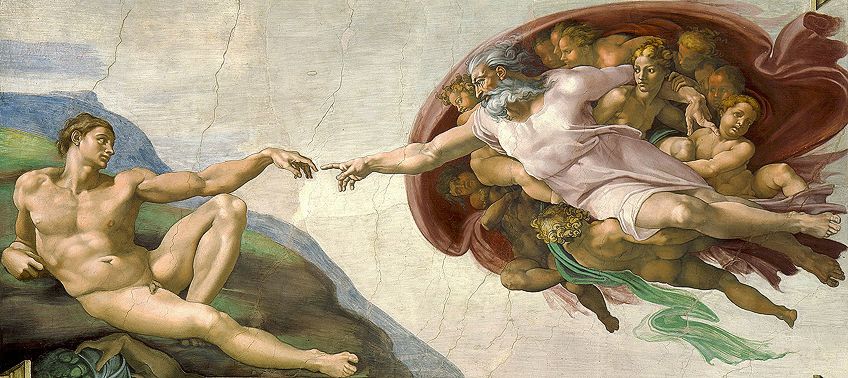 The Creation of Adam (c. 1511) past Michelangelo;Michelangelo, Public domain, via Wikimedia Eatables
The Creation of Adam (c. 1511) past Michelangelo;Michelangelo, Public domain, via Wikimedia Eatables
We also notice this keen attention to detail in his sculptures, for example, his earlier statue called Bacchus (1496-1497), the Piet à (1498-1499), and the pop David (1501-1504). The Piet à was carved out of one block of marble within a timeframe of ii years. It depicts the Mother Mary belongings the dead body of Jesus Christ. What is dissimilar from other depictions of this religious scene is the calmness Michelangelo chose to portray. Mother Mary is portrayed as a younger female and her facial expression has a tenderness that enhances the emotional aspects of the sculpture when viewing it.
Michelangelo as well constructed the sculpture according to a pyramid's shape – the top tip starts at Female parent Mary's caput and the widening from her robes creates the downwards motion, and sides of the pyramid, and the foundation is indicated by the base the figures are on.
When nosotros look at Michelangelo's statue, David, the artist portrayed the biblical effigy in the nude equally a strong boyfriend. We tin come across how he confidently stands in a contrapposto opinion, one of the typical Italian Renaissance characteristics. What is particularly evident from this statue is Michelangelo'due south proficient attention and agreement of the human form and beefcake carved in marble. Although in that location take been many sculptors during the Renaissance who carved the character of David, Michelangelo's rendition has stood stiff above all the others.
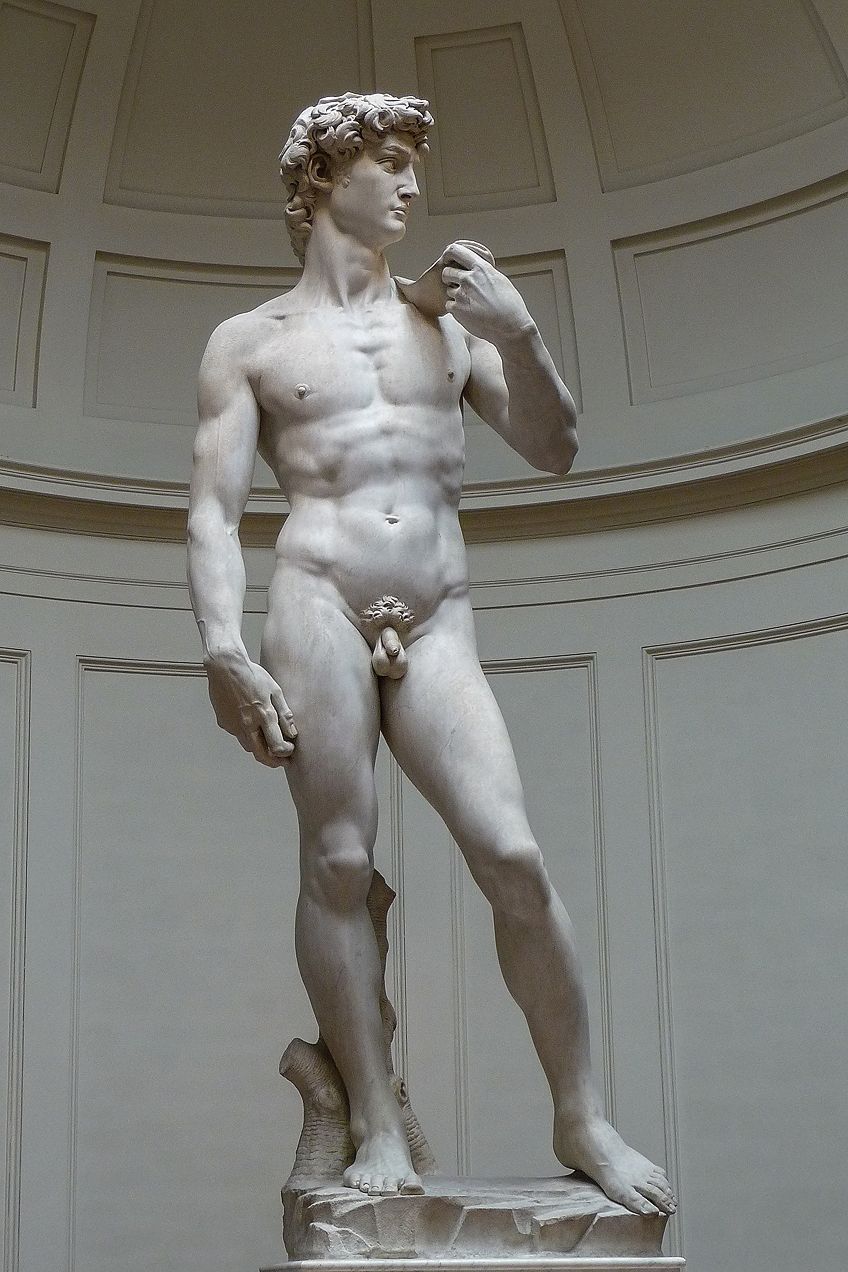 Michelangelo's David (1501-1504), Galleria dell'Accademia, Florence;Jörg Bittner Unna, CC BY 3.0, via Wikimedia Commons
Michelangelo's David (1501-1504), Galleria dell'Accademia, Florence;Jörg Bittner Unna, CC BY 3.0, via Wikimedia Commons
Raphael (1483 – 1520)
Raphael (Raffaello Sanzio da Urbino) was another main of the Renaissance menstruum and rival to Leonardo da Vinci and Michelangelo. He grew upwardly in Urbino and started his artistic career from childhood taught by his father who was also a painter. He somewhen moved to Florence because of various artistic endeavors and commissions. Artistic techniques used past Leonardo da Vinci influenced Raphael, namely sfumato and chiaroscuro.
What set Raphael apart from other Renaissance artists was the way he created his own style, which while withal based on the classical principles of the time, also depicted a sense of dazzler and grandeur, notably in his use of vibrant colors.
Some of Raphael's famous artworks include 2 frescoes, namely, Disputation of the Holy Sacrament (1510), and The School of Athens (1509 – 1511), both painted in the Stanza della Segnatura, which is 1 of 4 rooms with frescoes painted by Raphael in the Apostolic Palace in State of the vatican city – these rooms are too known as the "Raphael Rooms".
The School of Athens is an iconic piece of work by Raphael, it depicts a group of philosophers standing in a slap-up hall. As the name suggests, these are philosophers from the Classical era. In the center are Plato and Aristotle, with various other renowned figures around them similar Pythagoras, Ptolemy, and others.
 Scuola di Atene ('Schoolhouse of Athens', 1509–1511) fresco by Raphael, located at the Raphael Rooms, Apostolic Palace, Vatican city;Raphael, Public domain, via Wikimedia Eatables
Scuola di Atene ('Schoolhouse of Athens', 1509–1511) fresco by Raphael, located at the Raphael Rooms, Apostolic Palace, Vatican city;Raphael, Public domain, via Wikimedia Eatables
This fresco is an ideal example of the Italian Renaissance characteristics considering of the utilise of linear perspective and architectural structures creating depth and three-dimensionality. Raphael depicts calorie-free and dark in a way where it creates a further 3-dimensionality, specifically noticeable from the light inbound the building from the background, with a hint of blue clouds visible through the windows.
We besides notice a depth of architectural and structural skill from the artist in the surrounding building, arches, and vaulted ceiling. The large arc in the foreground creates a frame-like effect, and it is as if the stage is set, and nosotros are a part of the scene of contemplative and arguing philosophers. Additionally, Raphael did not focus on any i area with a richer color than the other, making the composition easier to witness and unifying all the elements.
Renaissance Across Italy and Into the Future
While Italia was the cultural hub for the development of the Renaissance, it undoubtedly spread to other European countries with prominent artists like German Albrecht Dürer and the Dutch / Flemish Renaissance painter Pieter Bruegel. Furthermore, the Venetian School was established in Venice with prominent artists similar Titian who influenced artists from subsequently art movements like the Baroque.
The Italian Renaissance period reached an stop effectually 1527 due to many factors like war, specifically the Autumn of Rome. The catamenia that came later on the Renaissance was chosen Mannerism, which started around 1520 in Rome and Florence. Mannerism was some other branch of Italian fine art that sought to movement away from the classical and naturalistic ideals established by the Italian Renaissance artists – fine art became more symbolic and figurative.
It is no incertitude that the Italian Renaissance as a historical flow and an Italian art period left an imprint on the cultural footprints for centuries to come. With new discoveries and inventions across nearly all the humanities and intellectual faculties, it was the paradigm of a "rebirth" equally the name suggests. Furthermore, Italian Renaissance artists set the stage and standards of art in the future, every bit we still see the masterpieces of antiquity emblazoned in our contemporary popular civilisation – the "Renaissance Man" lives on.
Frequently Asked Questions
What Was the Italian Renaissance?
The Italian Renaissance was a menses in European history that made a dynamic transition from the Medieval period. Information technology was a menses of "rebirth", which is too the definition of the term Renaissance. It ushered in a new way of seeing life, man, and God. It was a cultural move that incorporated all the disciplines like art, science, religion, geography, astronomy, compages, literature, music, and more than. It sought to reestablish the classical ideals that were forgotten from the Greek and Roman periods.
When Did the Italian Renaissance Showtime?
The Renaissance started during the 14thursday century and lasted for several decades. Italian Renaissance fine art is categorized into three periods, namely the Proto-Renaissance period (1300s), the Early Renaissance menstruum (1400s), and the Loftier Renaissance (1500s).
What Characterized the Italian Renaissance?
The Italian Renaissance characteristics were primarily centered on new perspectives from discoveries made in the arts and sciences. Humanism became one of the main philosophies, placing man at the heart and redefining the relationship with the Divine. This was especially noticed in how fine art became more than humanized and naturalistic, reverting to the classical ideals of perspective and proportion in how human figures were portrayed.
Source: https://artincontext.org/italian-renaissance-art/
Post a Comment for "In What Ways Did Renaissance Art and Philosophy Reinforce Each Other?"